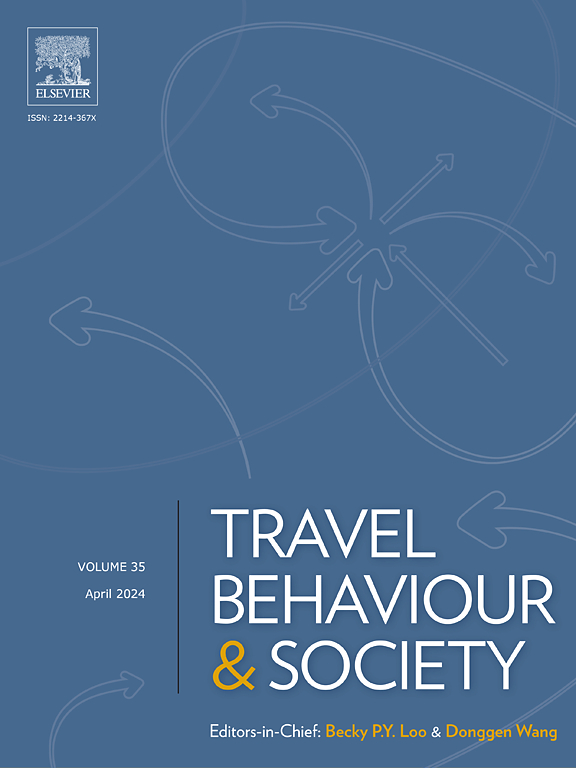A novel pattern recognition technique to characterize multi-day shopping and entertainment trip activities
IF 5.7
2区 工程技术
Q1 TRANSPORTATION
引用次数: 0
Abstract
The driving force behind individuals’ travel behavior is closely linked to the need to engage in various activities, such as working, shopping, and entertainment. While the importance of shopping and entertainment activities is well-documented in activity-based modeling research, there is no existing literature specifically addressing different shopping activities and entertainment trips over long time periods, such as an entire week, with a granular level of investigation. This study introduces a novel framework using comprehensive pattern recognition modeling, aiming to identify households’ level weekly shopping and entertainment trip activity patterns and to identify their representative patterns. Utilizing data from the 2019 Puget Sound Regional Household Travel Survey, the one-week activity patterns are split into 336 30-minute intervals. Each interval is comprised of information on trip activity types, duration, and start time. Pattern complexity of activity sequences in the dataset is recognized using the two-staged clustering process involving affinity propagation (AP) and k-means algorithms, which results in six unique clusters of homogeneous weekly activity patterns. These clusters exhibit a heterogeneous diversity in the temporal distribution of trip activity durations and significant differences in a variety of sociodemographic variables. Moreover, using sequence alignment techniques, we identified the representative trip activity pattern of the households in each cluster. Notably, younger individuals tend to shop on weekends, while older adults (age 65+) maintain consistent daily shopping habits. Households with higher incomes and vehicle access typically shop midweek, whereas a significant portion of high-income households without vehicles opt for Monday shopping. This comprehensive analysis highlights the intricate relationship between recreational travel behavior and sociodemographic factors, shedding light on nuanced patterns of activity engagement over extended time periods.
一种新的模式识别技术,用于描述多日购物和娱乐旅行活动
个人旅行行为背后的驱动力与从事各种活动(如工作、购物和娱乐)的需求密切相关。虽然购物和娱乐活动的重要性在基于活动的建模研究中得到了充分的证明,但没有现有的文献专门针对长时间内不同的购物活动和娱乐旅行,比如一整个星期,进行细致的调查。本研究引入了一种全新的框架,利用综合模式识别模型,旨在识别家庭层面的每周购物和娱乐旅行活动模式,并识别其代表性模式。利用2019年普吉特海湾地区家庭旅行调查的数据,一周的活动模式被分成336个30分钟的间隔。每个间隔都包含有关旅行活动类型、持续时间和开始时间的信息。使用涉及亲和传播(AP)和k-means算法的两阶段聚类过程来识别数据集中活动序列的模式复杂性,从而得到6个独特的同质每周活动模式聚类。这些集群在旅行活动持续时间的时间分布上表现出异质多样性,在各种社会人口变量上表现出显著差异。此外,利用序列比对技术,我们确定了每个集群中具有代表性的家庭旅行活动模式。值得注意的是,年轻人倾向于在周末购物,而老年人(65岁以上)则保持稳定的日常购物习惯。收入较高且有车辆的家庭通常在周中购物,而很大一部分没有车辆的高收入家庭选择在周一购物。这项综合分析强调了休闲旅游行为与社会人口因素之间的复杂关系,揭示了长时间内活动参与的微妙模式。
本文章由计算机程序翻译,如有差异,请以英文原文为准。
求助全文
约1分钟内获得全文
求助全文
来源期刊

Travel Behaviour and Society
TRANSPORTATION-
CiteScore
9.80
自引率
7.70%
发文量
109
期刊介绍:
Travel Behaviour and Society is an interdisciplinary journal publishing high-quality original papers which report leading edge research in theories, methodologies and applications concerning transportation issues and challenges which involve the social and spatial dimensions. In particular, it provides a discussion forum for major research in travel behaviour, transportation infrastructure, transportation and environmental issues, mobility and social sustainability, transportation geographic information systems (TGIS), transportation and quality of life, transportation data collection and analysis, etc.
 求助内容:
求助内容: 应助结果提醒方式:
应助结果提醒方式:


